There are two big questions heading into Arkansas’ open date. First, how much will the defense improve when the secondary finally gets healthy, as it should with a week of rest? And second, is the offensive performance we saw against BYU (644 yards and 52 points) replicable against the rest of the schedule? That is, are the changes the Hogs made in terms of strategy and playcalling something that will work against SEC defenses?
This post aims to answer the second question. To start, let’s just note that BYU was starting 230-pound defensive linemen. You’re not going to see that in the SEC. In terms of advanced stats, BYU’s defense now ranks 102nd in EPA+/Play. The Hogs’ remaining opponents rank 32nd, 13th, 43rd, 88th, and 12th. The only one that’s close to BYU’s is Ole Miss.
So Saturday’s offensive explosion is not exactly a sign that things will go swimmingly for the offense moving forward. But Sam Pittman claimed after the game that the Hogs made some significant changes to the offense for the BYU game. Actually, as we’ll see, those changes started the previous week against Mississippi State, and even with a backup quarterback, they started to show immediate results that carried over into Saturday.
What was going wrong for the offense?
Arkansas’ offense has been good this season, better than last year. The Hogs have risen from 25th to 16th in EPA+/Play. The main issue fans have had with the offense is that the defense’s collapse (27th to 109th) means that the offense now has to keep up in shootouts.
So we’re not looking at the offense as though it’s broken, just that it hasn’t been elite. With a veteran quarterback, a veteran offensive line, more consistent running back play, and a deeper receiving corps, it’s not wrong to expect even more. So what’s holding the offense back?
Short answer: explosive plays
The Hogs have fallen from 20th to 52nd in overall explosiveness from last year to this year. This has been most evident on standard downs – that is, downs where the offense is “on-schedule” and the defense can’t be sure what to expect, like first down or 2nd-and-6 – where explosiveness has tanked from 16th to 50th. The Hogs are very efficient: 25th in standard downs success rate and 13th in leverage rate (percentage of plays where the offense is on-schedule), but they aren’t creating big plays.
As a result, the Razorbacks are going on long drives (23rd in plays per drive), but both turnovers (64th in turnover rate) and issues in the red zone (50th in points per scoring opportunity) have kept the Hogs from scoring more points. The Hogs crushed South Carolina with brutal efficiency, but against the better defenses of Texas A&M, Alabama, and Mississippi State (and, concerningly, Missouri State), the Hogs had too many drives start well and then peter out.
A couple weeks ago, we looked at explosiveness in the passing game, noting that Kendal Briles was calling about the same amount of deep passes, but that they just weren’t hitting as often. The loss of Treylon Burks is probably the most significant factor. In terms of stats, we’ve seen Jefferson being slightly less accurate on deep throws and checking down more often. However, after the BYU game, the Hogs are up to 26th in passing explosiveness and all the way up to 8th in EPA+/pass, so the pass game on the whole is better than it was last year.
Shorter answer: run game explosiveness
That leaves us with the run game. The 2022 run game is slightly more efficient – 39th to 36th in rushing success rate – but explosiveness has tanked from 20th to 65th. That’s the main driver of Arkansas’ explosive play issues.
So why is the run game creating fewer big plays? It has everything to do with Arkansas’ run blocking scheme. The Hogs have been about 75% zone scheme and 25% gap scheme in the run game this year. There are two basic zone runs: inside zone and outside zone. Inside zones go over the guard and are typically very efficient but not very explosive. Explosive runs are generated by outside zone. You can read more about this in the BYU preview, where we looked at the “wide zone” offense that is all the rage in the NFL right now, and has a run game built around outside zone. Basically, outside zone forces second-level run defenders (like linebackers) to cover sideline-to-sideline to stop the run game, and any missed run fits can create a huge play, especially because zone reads give the back the option to cutback against the play and make someone miss in space.
But Arkansas’ offense is struggling with outside zone right now. For the season, the Hogs have run outside zone 65 times for 273 yards (4.2 per rush) with just a 28% success rate. As many runs have been stuffed as gained 6+ yards (23%).
Inside zone has been a friend of the offense – 111 rushes for 633 yards (5.7), 52% success, 41% gain 6+ yards – but without outside zone, the Hogs aren’t ripping off huge gains as often as they’d like. There are a few potential reasons why outside zone is struggling:
- It’s not Rocket Sanders’ best run. Arkansas’ best outside zone runner over the last two years has been Trelon Smith, who is now at UTSA. All-around, Sanders is a much better running back, but outside zone isn’t his specialty.
- Arkansas’ tackles aren’t as good as the interior line. Outside zone requires a great block from the playside tackle, which is either Luke Jones or Dalton Wagner, depending on run direction. Those guys are good, but they aren’t as good run blockers as Brady Latham, Ricky Stromberg, and Beaux Limmer.
- Trey Knox is playing tight end. Some outside zones run to the tight end side and require a good block from the tight end. Knox is a receiving specialist, and the Hogs are sacrificing some run blocking to have him lined up as a traditional tight end.
There may be other reasons, but those jump out to me.
Kendal Briles’ role in all this
Briles’ background may be relevant for understanding how to get more out of Arkansas’ offense.
At Baylor
Kendal worked for his father Art Briles at Baylor, rising in the ranks to eventually become offensive coordinator. Art created an incredibly-productive offense at Baylor that was mostly of his own design. The basic idea of the Baylor offense was to maximize the contrast between speedy receivers and big run blocking linemen. Some offenses try to be fast, others try to be big, but Briles wanted Baylor to be both.
Briles recruited really fast receivers and threw downfield regularly. Outside receivers often ran deep fades, while slot receivers ran a “slot choice” of Briles’ design: a vertical route which the receiver could convert into a post, dig, or corner depending on how the safety played it. These routes pushed the safeties back, while Briles also pioneered the use of very wide splits – outside receivers often lined up against the sideline – to force underneath defenders to move out with him, leaving them unable to defend against the run.
And then Baylor would run the ball. The 2016 Bears ran the ball 54 times per game, most in the FBS outside of service academies. It was definitely a “throw-to-run” offense. To contrast with the speedy receivers and wide splits, Briles recruited huge offensive linemen (that probably got Sam Pittman’s attention when he was looking for an offensive coordinator) and ran gap scheme power runs, complete with pulling linemen.
At FAU
College defenses began to adjust to offense’s like Baylor’s, popularizing ideas like Quarters coverage (more flexibility to the secondary in covering deep routes) and Tite fronts (easier to stop a gap scheme run game without stacking the box). Realizing the offense needed to adapt in a post-Art Briles era, Kendal went to FAU and joined up with Lane Kiffin.
Kiffin’s background is very different. He was mentored in a West Coast offense system by none other than Norm Chow, the USC offensive coordinator during the Matt Leinart and Reggie Bush national title season in 2004. While Baylor’s offense was all about power running and vertical passing, Kiffin’s offense was all about zone running and horizontal passing. Kiffin swiped a lot of Baylor’s terminology and ideas about “gas” plays (quick playcalls when running tempo, usually after a big play), while Briles added a ton of Kiffin ideas into his own scheme.
At Arkansas
Arkansas’ offense for three seasons has looked a lot like Ole Miss’, but with more Baylor touches. The Hogs are primarily a zone run team and they try to stretch the defense horizontally with RPOs. But there’s still been touches of the power run game and a few more vertical shots in the passing game that makes Arkansas distinct.
Not being able to hit as many big plays this year has probably been frustrating for Briles. After all, he came up in a system famous for big plays. His attempts to use trick plays to jump-start the offense have mostly backfired and drawn a ton of fan ire, so at some point (in Pittman’s telling), Pittman told him to “open up” the offense, presumably meaning the base offense.
Here are some changes that we’ve seen.
Throwing on early downs
Against BYU, the Hogs came out throwing. That was a big change. Here are Arkansas run and pass rates on first down in each FBS game this year:

The Hogs had great balance against Cincinnati before playing three straight SEC games very conservatively. As you can see, the Hogs threw more on first down against Mississippi State even with KJ Jefferson out. And then against BYU, the offense truly opened up, with more passes than runs on first down for the first time all year.
Conservative offenses tend to be very run-heavy on first down with the goal of just getting about four yards to stay on-schedule. As mentioned above, Arkansas has been very on-schedule, but it’s hard for conservative offenses to hit big plays.
Arkansas’ extremely-low first-down pass rates are especially concerning when you consider just how good Jefferson is at throwing the football. As evidence, consider this, from ProFootballFocus:
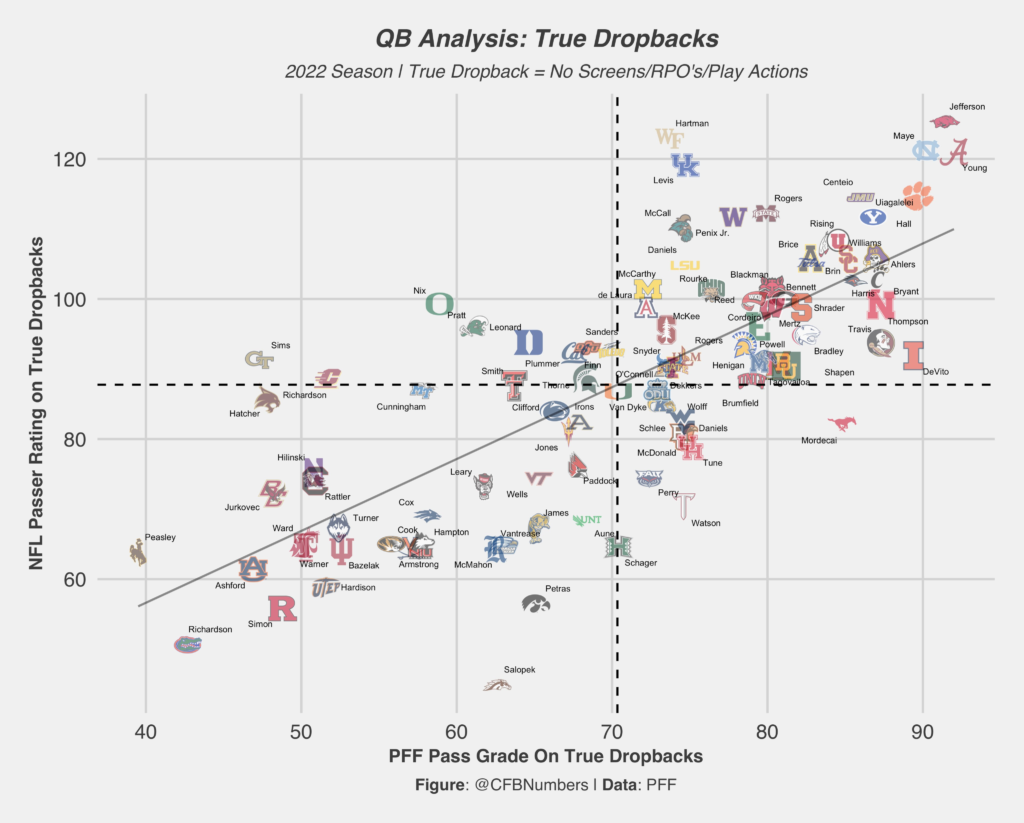
According to PFF’s data, Jefferson is the best quarterback in the country on “true” dropbacks, which exclude screens, RPOs, and play action. Now, there are some potential issues. SEC Stat Cat, whose data we will use below, ranks Jefferson as just the fourth-most accurate quarterback in the SEC on dropbacks (though his data does not separate out play action). Also, the graph above does not include Hendon Hooker for some reason, and he’d likely rank near the top. So there are some potential quibbles.
The general point remains: Jefferson is a very good passer on non-RPOs – that is, on called passes – and with opponents largely aiming to stop Arkansas’ run game, the Hogs should, in theory, be throwing more on plays where the defense doesn’t know what’s coming.
Those run/pass rates can be further broken down into called runs, called passes, and RPOs (call data courtesy of SEC Stat Cat). Here’s how that looks for first downs:

So the Hogs used more called passes and fewer RPOs against BYU, while maintaining about the same called run rate.
Note the decline across the Carolina-A&M-Alabama stretch that saw the Hogs using a ton of called runs (South Carolina) or RPOs (A&M and Alabama) instead of called passes. The Hogs are now 2-1 when the called pass rate is above 28% on first down and 0-3 when the RPO rate is above 30%.
The idea behind replacing called passes with RPOs is noble enough, but it just doesn’t suit Arkansas’ offense. Here are the success rates and yards per play on standard downs playcalls for each game:

The main thing to note is that production-wise, the BYU game was not exceptional in terms of first down called passes. The only difference was that Arkansas threw it more. They should keep doing that.
Even with a good game against BYU, RPOs are producing 5% less success and less than half the yards per play of called passes. The Mississippi State game is an outlier because of the backup quarterback, but in no game this season has the RPO been the best option in terms of yards per play, and in only one (BYU) has it been the most successful.
Called passes, meanwhile, have been the most successful option in four of six games and the best yardage gainer in five of six.
More power running
Against BYU, the Hogs paired their more pass-heavy attack with more gap-schemed power runs.
The old Baylor system was power runs and vertical passing, while the Kiffin system is mostly zone runs and horizontal passing. It feels like Arkansas has looked too much like Ole Miss at times this year, with tons of horizontal passes and mostly zone runs.
The Hogs have been much more vertical over the last two weeks, and against BYU, they flashed much more power running. Check it out:

After just three gap-schemed runs against Cincinnati, it looks like Arkansas tried to work more gap runs into the run game over the next two FBS games, but outside of the Bash Read, these looks were not overly successful, so they were largely abandoned over the next two games. Against BYU, the Hogs showcased several new wrinkles in their power run game.
Let’s meet Arkansas’ main gap-schemed runs.
Dive
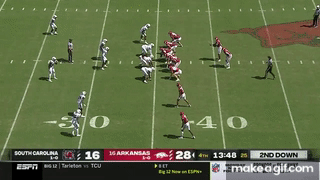
The most-used gap run we’ve seen this year has been Dive (18 carries, 70 yards, 72% success), which is just a B-gap run (no pullers) mostly used in short-yardage situations. Despite the high success rate, Dive has a negative EPA/rush for the season due entirely to the fact that Jefferson’s fumble against Texas A&M cost the Hogs an astonishing 12.8 EP. Without that one rep, the Dive has a positive EPA/rush.
Bash Read
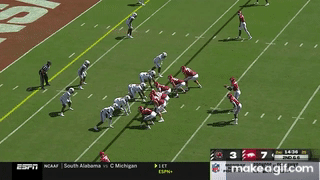
Bash Read – previously known as Power Veer, or just “the Cam Newton play” – is a powerful outside zone run for a running quarterback. The “bash” is the outside run by the back, but the quarterback has the option to run inside if the unblocked defender sets the edge.
Bash Read has been a great play for the Hogs: 11 carries, 91 yards, 54% success, zero runs for no gain or loss, and 54% of runs gain 6+ yards. Since outside zone has struggled, this has been Arkansas’ best bet to run outside. After it gashed South Carolina a few times (including that touchdown), I’m a bit surprised we haven’t seen more of it.
Counter
The more significant gap run is the Counter, which is the only play with multiple reps this season that uses pulling linemen. The Hogs have tried several different forms of Counter, including two new ones against BYU. Let’s look at the Counter lineup.
GT Counter
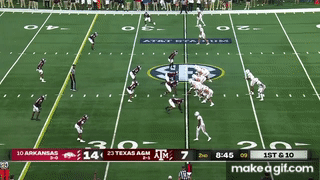
Until Saturday, this was the main form of Counter. Both the backside guard and tackle pull to the playside (hence “GT”) and lead the way for the back. The Hogs only used this twice against BYU, but for the season, it’s up to 11 carries for 37 yards with only three successful reps.
Variations. The base play is a called handoff, not a read, which might explain why it struggles to beat stacked boxes. The Hogs have a few reps as a Q GT Counter, meaning that’s there no handoff and Jefferson (“Q”) is running the counter himself. And three times this season, the GT Counter has been attached to an RPO (Jefferson handed off on all three).
There was also this absolutely filthy RPO against BYU. The Hogs have not run anything like this all season:
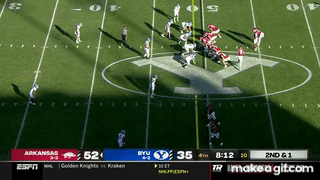
That’s Haselwood on orbit return motion, giving Jefferson the option of throwing the swing pass or running Q GT Counter. I want more of this play.
Bash GT Counter Read
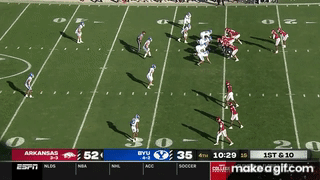
This fun play combines a Bash Read with a Q GT Counter. Jefferson reads the unblocked defender and can either handoff on the bash or run the counter himself. The Hogs have run this one 5 times for 14 yards this season, including three times against BYU. In the above gif, Jefferson makes an incorrect read and the play fails.
Variations. The first use this season (against South Carolina) actually saw Haselwood carry on the Bash. One of the reps against BYU was an RPO with an attached hitch route (Jefferson couldn’t make the throw and scrambled for no gain).
G Counter Read
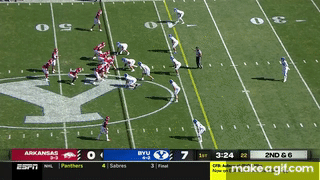
This version of Counter uses an H-back as a puller instead of the backside tackle. Like the Bash GT Counter, its base form is as a read, with Jefferson able to run outside if the unblocked defender loses the edge. Until Saturday, the Hogs had only run this one once (against South Carolina), but they tried it six times against BYU. Rocket Sanders’ 64-yard touchdown run came on this play (with Hudson Henry as the H-back!), and for the season, it’s up to 7 carries for 107 yards with three successes. I would expect to see this one more often.
Variations. Six of seven reps have been the base G Counter Read play. The Hogs added bluff action to one rep against BYU.
More Counter?
The Hogs have now run 23 counters for the season, and almost half of them (11) came against BYU. Again, part of it was BYU’s very not-SEC defensive line, so don’t expect to power-run the remaining schedule to death.
However, as the Hogs are struggling to get the outside zone game working, power runs give them a way to at least force the defense to stack the box and open things up for the early-downs passing game…. or punish the defense for over-adjusting to the pass, as we saw against BYU.
New wrinkles
The Hogs tried several new looks against BYU. We diagrammed the fun RPO that combined a Q GT Counter and a swing pass off orbit return motion above, but here are a few others.
Sprint Draw RPO
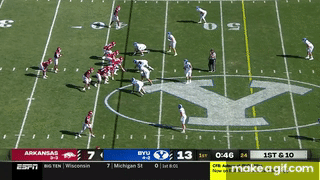
This was anther new RPO look that we saw, and while it didn’t work, it’s a well-designed play. Jefferson can hand off, throw the quick out at the bottom of the screen, or run it himself.
Bluff Jet End Around
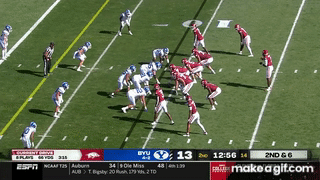
This is just more cleverness to try and run outside the tackles. The Hogs bring Rashod Dubinion in jet motion and fake a split zone handoff to him before tossing the ball to Jadon Haselwood, coming from the bunch set on an end around. Pretty clever.
Leak
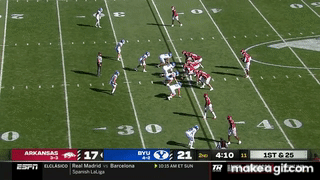
Leak/throwback concepts are really dangerous for a quarterback like Jefferson who is a threat to run. This was a huge play as it came right after Nathan Bax’s blindside block made it 1st-and-25.
Top passing concepts
Here were the most used concepts of the game.
- Screens: 6 plays, 5 successful (83%), +0.49 EPA/play, 8.0 yards/play – four of these were little RPO tunnel screens because BYU was giving so much cushion; we also saw one middle screen and one slip screen to Dubinion
- Flood: 5 plays, 1 successful (20%), -0.41 EPA/play, 2.6 yards/play – all three incompletions of Arkansas’ second drive were Flood concepts
- Shot Plays: 4 plays, 2 successful (50%), +0.94 EPA/play, 13.5 yards/play – the 39-yard bomb to Matt Landers was a shot play
The single biggest play in terms of EPA value was the 30-yard pass to Ketron Jackson on 3rd-and-10 after Arkansas’ lead had been cut to 38-35. We diagrammed it in the Box Score Breakdown, but here it is, recorded as a Shallow Cross:
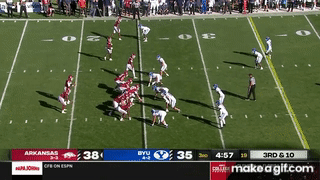
That play was worth 4.29 points by itself.
Thanks for reading! Be sure to follow us on Twitter.
The latest from Fayette Villains, straight to your inbox
Enter your email to subscribe and receive new post alerts and other updates. You can unsubscribe at any time.